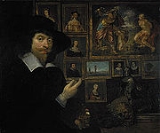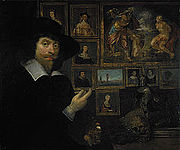
George Jameson
Encyclopedia
George Jamesone (c. 1587 – 1644) was Scotland
's first eminent portrait-painter
.

, where his father, Andrew Jamesone, was a stonemason. Jamesone attended the grammar school
near his home on Schoolhill and is thought to have gone on to further education at Marischal College
. Legend has it that Jamesone once studied under Rubens in Antwerp with Anthony van Dyck. This is, however, yet to be proven as his name does not appear to be noted on the Guild registers of the town. Since Rubens was exempt from registering pupils, the absence of Jamesone's name does not mean that the painter definitely did not study there. Jamesone certainly did complete an apprenticeship under the supervision of his uncle, John Anderson, who was a popular decorative painter in Edinburgh at the beginning of the seventeenth century. Jamesone finished this training in 1618. He is not recorded as being in Aberdeen again until 1620. If the Scotsman had gone to Antwerp, it would have had to have been between the years of 1618 to 1620.
and Marischal. In 1633, when Charles I
made his grand royal visit to Edinburgh, Jamesone rose from local to national fame. For this occasion the painter was asked to decorate a highly elaborate triumphal arch with the portraits of all the past kings of Scotland. He was also given the honour of painting the portrait of Charles himself. It has been said that the king was so pleased with the result that he gave Jamesone a ring off his own finger as a reward.
After hearing of the King's approval, many of the Scottish gentry desired to be painted by the now highly reputable George Jamesone. One of his finest examples is that of Mary Erskine
which is on display at the National Gallery of Scotland
. Jamesone had homes and studios in Aberdeen (on Schoolhill opposite St. Nicholas Kirk) and in Edinburgh (on the Royal Mile
right next door to John Knox House
). Having two bases allowed him to meet the demands of hundreds of patrons from the north to the south of the country.
, also went on to be a highly important portrait painter in seventeenth century British art. Although Jamesone had several children with his young Aberdonian wife Isabella Tosche, only one lived to adulthood. This was his youngest daughter Mary. Mary Jamesone inherited her father's artistic talents and excelled in the craft of needlework. Four examples of her dexterity, four scenes from the Old Testament and Apocrypha
, can be seen to this day in St. Nicholas Kirk in Aberdeen.
Scotland
Scotland is a country that is part of the United Kingdom. Occupying the northern third of the island of Great Britain, it shares a border with England to the south and is bounded by the North Sea to the east, the Atlantic Ocean to the north and west, and the North Channel and Irish Sea to the...
's first eminent portrait-painter
Painting
Painting is the practice of applying paint, pigment, color or other medium to a surface . The application of the medium is commonly applied to the base with a brush but other objects can be used. In art, the term painting describes both the act and the result of the action. However, painting is...
.

Early years
He was born in AberdeenAberdeen
Aberdeen is Scotland's third most populous city, one of Scotland's 32 local government council areas and the United Kingdom's 25th most populous city, with an official population estimate of ....
, where his father, Andrew Jamesone, was a stonemason. Jamesone attended the grammar school
Aberdeen Grammar School
Aberdeen Grammar School, known to students as The Grammar is a state secondary school in the City of Aberdeen, Scotland. It is one of twelve secondary schools run by the Aberdeen City Council educational department...
near his home on Schoolhill and is thought to have gone on to further education at Marischal College
Marischal College
Marischal College is a building and former university in the centre of the city of Aberdeen in north-east Scotland. The building is owned by the University of Aberdeen and used for ceremonial events...
. Legend has it that Jamesone once studied under Rubens in Antwerp with Anthony van Dyck. This is, however, yet to be proven as his name does not appear to be noted on the Guild registers of the town. Since Rubens was exempt from registering pupils, the absence of Jamesone's name does not mean that the painter definitely did not study there. Jamesone certainly did complete an apprenticeship under the supervision of his uncle, John Anderson, who was a popular decorative painter in Edinburgh at the beginning of the seventeenth century. Jamesone finished this training in 1618. He is not recorded as being in Aberdeen again until 1620. If the Scotsman had gone to Antwerp, it would have had to have been between the years of 1618 to 1620.
Career
Whilst in Aberdeen, Jamesone made a name for himself painting portraits of local academics and scholars from the city's two feuding colleges: King'sKing's College, Aberdeen
King's College in Old Aberdeen, Scotland is a formerly independent university founded in 1495 and an integral part of the University of Aberdeen...
and Marischal. In 1633, when Charles I
Charles I of England
Charles I was King of England, King of Scotland, and King of Ireland from 27 March 1625 until his execution in 1649. Charles engaged in a struggle for power with the Parliament of England, attempting to obtain royal revenue whilst Parliament sought to curb his Royal prerogative which Charles...
made his grand royal visit to Edinburgh, Jamesone rose from local to national fame. For this occasion the painter was asked to decorate a highly elaborate triumphal arch with the portraits of all the past kings of Scotland. He was also given the honour of painting the portrait of Charles himself. It has been said that the king was so pleased with the result that he gave Jamesone a ring off his own finger as a reward.
After hearing of the King's approval, many of the Scottish gentry desired to be painted by the now highly reputable George Jamesone. One of his finest examples is that of Mary Erskine
Mary Erskine
Mary Erskine was a Scottish businesswoman and philanthropist, who donated money to set up the girls' school which is now known as The Mary Erskine School.-Biography:...
which is on display at the National Gallery of Scotland
National Gallery of Scotland
The National Gallery of Scotland, in Edinburgh, is the national art gallery of Scotland. An elaborate neoclassical edifice, it stands on The Mound, between the two sections of Edinburgh's Princes Street Gardens...
. Jamesone had homes and studios in Aberdeen (on Schoolhill opposite St. Nicholas Kirk) and in Edinburgh (on the Royal Mile
Royal Mile
The Royal Mile is a succession of streets which form the main thoroughfare of the Old Town of the city of Edinburgh in Scotland.As the name suggests, the Royal Mile is approximately one Scots mile long, and runs between two foci of history in Scotland, from Edinburgh Castle at the top of the Castle...
right next door to John Knox House
John Knox House
The John Knox House is an historic house in Edinburgh, Scotland, reputed to have been owned and lived in by Protestant Reformer John Knox during the 16th century, but known not to have been .The house itself was built from 1490 onwards, featuring a fine wooden gallery and hand-painted ceiling...
). Having two bases allowed him to meet the demands of hundreds of patrons from the north to the south of the country.
Legacy
Jamesone's pupil, John Michael WrightJohn Michael Wright
John Michael Wright was a portrait painter in the Baroque style. Described variously as English and Scottish, Wright trained in Edinburgh under the Scots painter George Jamesone, and acquired a considerable reputation as an artist and scholar during a long sojourn in Rome...
, also went on to be a highly important portrait painter in seventeenth century British art. Although Jamesone had several children with his young Aberdonian wife Isabella Tosche, only one lived to adulthood. This was his youngest daughter Mary. Mary Jamesone inherited her father's artistic talents and excelled in the craft of needlework. Four examples of her dexterity, four scenes from the Old Testament and Apocrypha
Apocrypha
The term apocrypha is used with various meanings, including "hidden", "esoteric", "spurious", "of questionable authenticity", ancient Chinese "revealed texts and objects" and "Christian texts that are not canonical"....
, can be seen to this day in St. Nicholas Kirk in Aberdeen.

